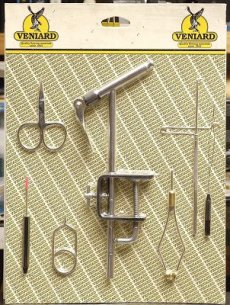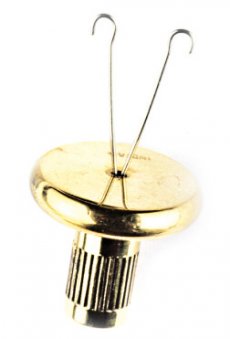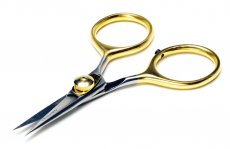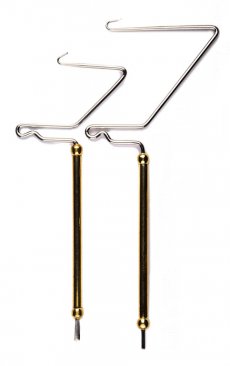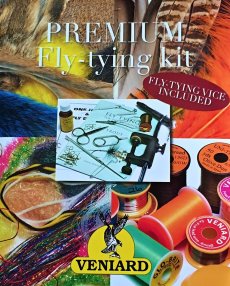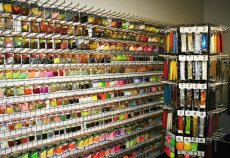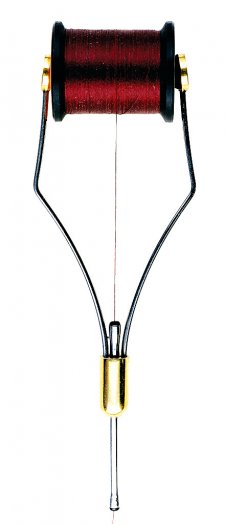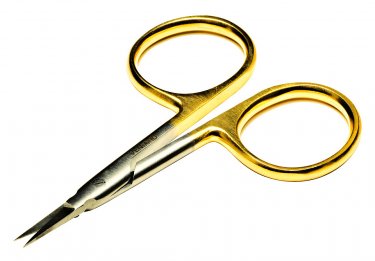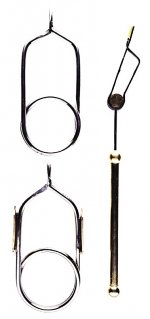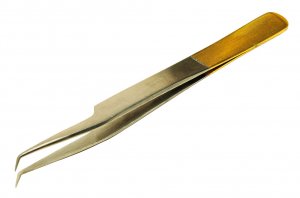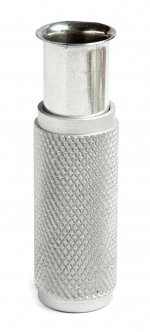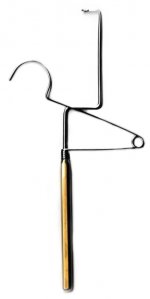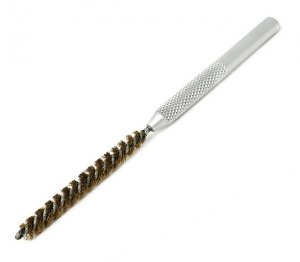In this article you will learn the main meaning, use and all the benefits of basic FLY TYING TOOLS - from fly tying vice to very useful accessories and the necessary small tools used for fly tying all kinds of artificial flies!
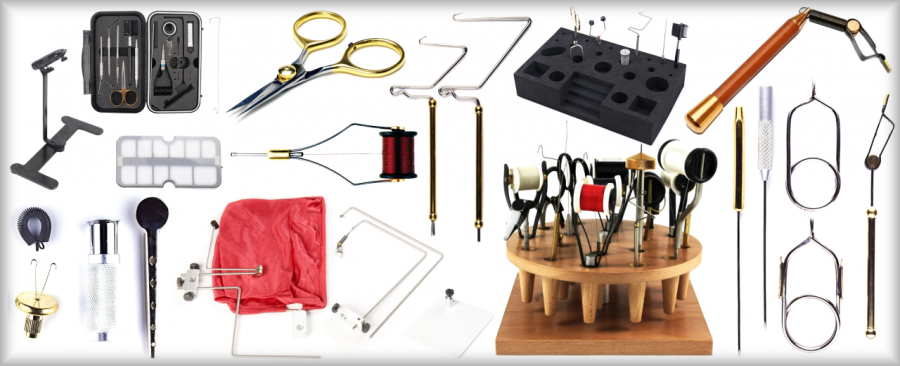
The fly tying and look of flies has undergone tremendous development over the last few years! Artificial flies and various new styles of fishing with them, have become an increasingly controversial topic, which instead of joining the fly fishermen rather divided into more opinion / access groups! This development is unlikely to be halted and we will probably not influence the global situation. But the great advantage is that we can choose our own way, which we can go in fly tying and in our beautiful fly fishing sport!
However, in addition to the ever-increasing range of fly tying materials, there are also some specific tools within the fly tying itself, which have not undergone such a noticeable development and which make the process of almost magical fly creation much simpler and more comfortable than before in times when the fly tiers were only dependent on the skill of their own hands! In my early beginnings of discovering the beauty of fly fishing and fly tying, I myself have not used any currently available tying tools. Only one hand holding the hook, while the other hand tied new and new materials to it the resulting imitation of a dry caddis, which I initially exclusively fished, absolutely everywhere! :-)
Thanks to these experiences - and I am very happy to remember them - today I can fully appreciate the main significance and all the advantages of the basic and now indispensable FLY TYING TOOLS, which I would like to introduce to you in this article!
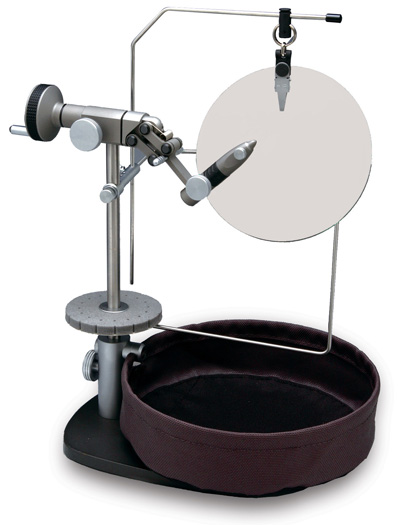
FLY TYING VICE: There are many quality vices and it is possible to obtain them from many world as well as domestic producers. Given that the vice has probably undergone the greatest development of all fly tying tools, we can describe their main features, advantages / disadvantages and mutual differences on different types of fly tying vices, which I would divide into the following basic groups.
First of all, I would mention the most basic type, namely the STANDART vice. This type of vise is both the oldest and the simplest and its main task is only to firmly hold the fly hook in the jaws. This type of tying vice is best suited for beginners who are still learning and do not want or cannot invest too much money, which is also its main advantage - low price! In my opinion, however, it stands out by a number of disadvantages, which include its immobility - the impossibility of positioning vices in any way and speed during the individual tying steps with the fly. The jaw tightening system is also not ideal. The individual parts are pressed against each other, which results in deterioration of these parts and consequently low jaw compression strength. These vices do not even use good steel today, which often leads to very rapid squeezing of the jaws, which are then unable to firmly grip smaller hooks, which when tying different turns, etc. Of course, there are good types, but due to the existence of other models I recommend this type of vice mainly to the beginning or on the trips where we need something small and light to do the job - travel vice!
Another type is the SPRING vice, which is based on the opposite principle of the action of the jaws force on the attached hook, which is a much better and more reliable solution than the standard type. To explain it simply. In the standart type, we tighten the jaws together! While in this spring vice, the jaws are already tightly pulled together and we only open them counter-force with a lever to place a hook in them. As soon as the lever is released, the jaws tighten the hook! These vices have started to combine more functions, so the lever vices are often very mobile - we can position them in different ways and rotate with our front sight. Furthermore, they are also made of much higher quality steel, so that the individual parts and especially the jaws are not damaged so quickly! They are, of course, in a higher price range, but it is an excellent compromise in price / performance. So I can recommend them to all binders - beginners, but also advanced!
The third type is the ROTARY vice, whose great advantage is that it usually has all of the positive features described above, which is of course great! Its main benefit, however, is the type of construction that allows the fly tier to rotate with the fly exactly around its axis, so it is possible to make many tying operations (twisting the body of brittle material, ribbing, winding of the hackles, etc.) even easier and faster. These vices are mostly of the highest quality materials with differently solved hooks in "jaws" (spring version, special system of hook pressure in the "jaws" eye - Jan Tvrdek Classic / Harmonic, but also reliable tightening jaws of standard type). Their disadvantage is that they are mostly the most expensive types - in the case that it is not a compromise solution - so I recommend them only to those who are really serious about binding, or. want to make you happy! ;-)
Lastly, I would like to briefly mention a vice FOR TYING TUBE FLIES with specific needle attachments on which plastic or metal tubes are threaded. This vise is mainly for salmon or streamer fly tier in the form of tube flies, or for real enthusiasts who must not miss anything because the tying of tube flies can be easily and economically solved by special attachments that fit into the jaws of most types of above mentioned vices. . This type is also rotary.
Fly tying vices of course exist in many hybrid designs that combine all kinds of basic types, etc., but such vices do not need to pay more attention - the vast majority of mortals can do with the above types!
FLY TYING BOBBIN: Bobbin is one of the basic and necessary fly tying tools - just after the vice. It is a very simple two-arm spool holder with tying thread through which the thread passes through the middle tube so that we can easily and accurately tie the thread on the hook shank and tie other fly tying materials. There are, of course, many types - from the very simplest and cheapest (Made in India, China) to the most prestigious and most expensive, which are differently tuned and you can even adjust the spool brake for different thread unwinding forces, which is an excellent feature frequent changing of thread spools with different widths. The most expensive ones can be found with ceramic tubes, which do not tear the thread, on the other hand, it is much more fragile and if, for example, the bobbin falls, the tube can break. Personally I think that every fly tier - beginner and professional - will do with the basic types, and that the most expensive types of bobbins are just another way for manufacturers and traders to make as much money as possible from irrelevant whims. I myself prefer a few plain bobbins with more thread spools than to have one expensive bobbin and constantly change threads on it. But of course this depends on each of us!
BOBBIN THREADER: I mention this tool here mainly in connection with the previous tool. However, it is rather an additional accessory, which will find the main application in frequent threading on one bobbin, or in the case of bobbin Japanese manufacturer C&F Design, which at the entrance of the thread into the tube with a foam notch, where this tool is necessary!
But when I thread the tying thread into the vast majority of my bobbins I can do without this tool thanks to such a small trick that most of you surely know. Who doesn't, I'll help him discover America today! ;-) Personally, I pull the thread through the bobbin tube so that I unwind a piece of thread from the bobbin, put it at the beginning of the tube, put the other side of the tube into my mouth and suck the thread from the other side! In my opinion, this is the fastest way without using another tool. Nothing, of course, for individuals who enjoy strict adherence to hygienic conditions even during fly tying! :-)
QUALITY SHARP SCISSORS: Another type of tying tool - we can hardly do tying flies without this! Thanks to high-quality scissors, we can adjust the material in various ways - trimming and once we have finished the fly, we can fine-tune it with scissors! Of course, this does not apply to all operations, but when cutting heads and bodies from deer hair (Muddlers, Goddard Caddis, traditional Popper Streamers and other dense materials that need to be scissors), scissors will find the main application. I recommend the scissors for delicate and detailed work - the sharpest and probably the most expensive, the larger sharp scissors for cutting larger and thicker materials (fur, synthetic hair) and cheaper steel scissors for hard work - cutting wires and materials, which can damage the scissors and if, you don't have to be disappointed!
HACKLE PLIERS: Pliers are our small and very useful helpers when we need to hold some fragile or small tying material (eg cock hackles, peacock quills, thin wires, fine ribbing material) and there is a risk of slipping between the fingers and the whole process we would have to repeat it several times, and we could irreversibly damage the material. Of course, in some cases we can do without the pliers, but these are toools that make tying much easier and if you do not want this task downright, I recommend you have at least 3, whether in the basic version (see picture) or in rotary version and with spring, which is more sensitive to the attached material after all! In the case that standard pliers tear feathers, I recommend putting on one side of the small jaws a small rubber tubing, which will solve this defect perfectly!
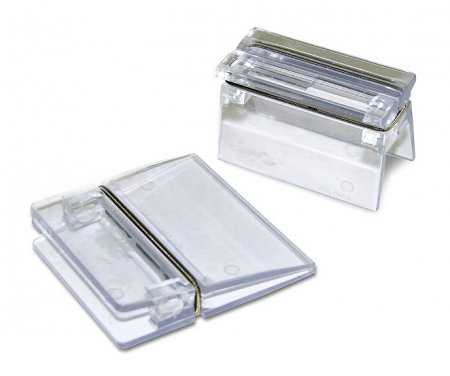
DUBBING, HAIR & FEATHER CLIPS: A special kind of gripper,/plier which we use mainly in the dubbing into the loop, or creating specific wicks from dubbing, hair or feathers directly during the tying the fly. This slips allows to attach a larger amount of tying material, which is then elegantly inserted into a pre-prepared loop from thread. Once we have done this and the material is attached between the two threads of the yarn, we can release the grip and loosen the loop using a rotary dubbing tool or dubbing fork to form a wick. This tying tool is certainly indispensable for all streamers, but also other types of flies, where we want to directly create long dubbing and other wicks!
DUBBING TOOL: This tying tool is a continuation of the previous clip. As described above, thanks to this tool, we can produce unique types of wicks very quickly, into which we can add anything that we want right during tying the fly! The traditional type is a classic dubbing fork with two hooks, which when pulled together and then turn the fork tighten the thread with the material. But if I can recommend you, definitely get rotary versions, which are very good quality and just hold and rotate the roller with the bearings, so you can quickly produce a tight wick! Just like the previous tool, indispensable for all who often practice the looping technique!
DUBBING NEEDLE: Excellent tool for the main use in painting individual parts of flies with varnish or in the final treatment of artificial flies in the process of combing and pulling longer dubbing fibers from the body + other detailed adjustments! If you drop the hook eye by mistake with glue or varnish, this problem will also solve the dubbing needle! Ordinary dubbing needles can easily be replaced with a larger type of classic sewing needles, but if you get a better model, on the other end you will find a simple knot finisher, which you can quickly end the artificial fly in the head. A simple but very practical and often used fly tying tool that must not be missing in our equipment!
TWEEZERS: Maybe many will wonder, but this is my most commonly used tying tool! I work with tweezers practically throughout the whole tying process. Whether it is a selection of hooks, beads, pulling individual parts of different tying materials, as well as holding the dubbing mixture while dubbing on the thread. I also use tweezers when dubbing to loop in the case of a smaller amount of material - shorter dubbing wicks or dubbing CDC legs in nymphs and wet flies. I also use tweezers in the final treatment of the fly - combing and pulling out individual fibers - and inserting smaller patterns into the fly box. The tweezers are in action all the time and I recommend you have at least three shape versions!
HAIR STACKER: Another very useful tying tool, for which we find application mainly when tying larger dry flies. This tool allows us to compare the deer hairs so that their ends were exactly together and none of them exceeded. Put the hair into the hole, tap the stacker a few times on the table - the hair will fall evenly to the bottom od hair stacker. Then you just need to carefully pull out the tube and hair bundle from it and take the ends of hair. Of course, fish do not pay attention to these details, but for aesthetes and fly tiers who take their hobby or profession seriously, it is another mandatory equipment of the fly tying bench!
WHIP FINISHER: A special tying tool that allows us to end the fly with several lost knots in a few moves! Personally, I do not use the whip finisher and always manage other ways of terminating all types of flies! But I do not doubt its importance and contribution! Again, there are several types, but the principle of their operation is always the same - to create a few simple knots in a row, which very stable fix the thread, which can then be cut and paint by varnish for sure! Definitely useful fly tying tool, but not indispensable i think!
DUBBING BRUSH: This is a great thing! Often, a fine steel brush is also part of the dubbing needle (C&F Design), but in most cases, we can use with a Velcro or with a cut toothbrush, but that is not effective way as a Velcro! You do not have to buy such a tool, just make it! Anyway, I highly recommend it, because it is the brush for combing dubbing helps us from nicely tied and smooth flies to create attractive and tasty prey for fish! Absolute necessity for every fly tier/ fly fisher who catches with flies and not just puts them in a box for pleasing the eye! ;-)

FLY TYING VICE ACCESSORIES: If you want to have a fully equipped tying vice with all these tying tools, be sure not to buy a complete set of accessories, which includes, for example, a maximally practical waste bag, a contrast plate against which you can comfortably see the fly, a bobbin holder arm for cases where during tying, you were more confused than a useful and special arm designed for fixing the parachute wings when tying dry flies, the so-called "Parachute". Usually every manufacturer of tying vices and tools has such a set of components of the assortment, so from personal experience I only highly recommend it!
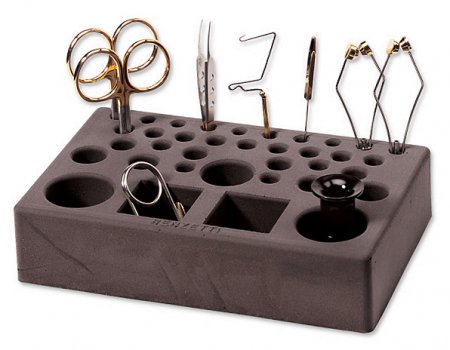
FLY TYING TOOLS ORGANISER: In case you do not want to have all the above mentioned fly tying tools freely thrown on the table or in a drawer, I recommend to everyone to buy a practical organizer, in which you clearly put the all tools and during the tying can gradually pull out and use.
These stands/organisers are manufactured in various designs - most often in wooden or light foam form. A great solution is a Travel fly tying tool set, which can hold the vast majority of the most commonly used fly tying tools and materials. Solid organisers with thorns are also excellent, on which you can put even the most frequently used spools of thread! There is a lot of variant, but I will leave the choice of a specific product to you! ;-)













